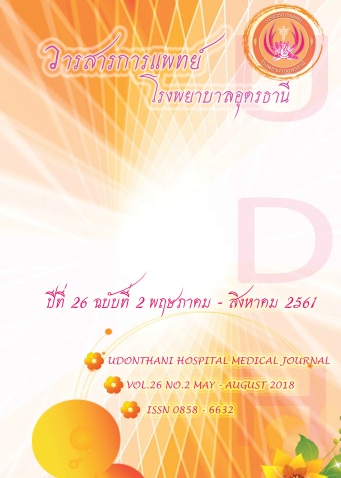รายงานผลการรักษาและปัจจัยเสี่ยงที่มีผลต่อการเกิดภาวะแทรกซ้อนหลังการผ่าตัดแผลกระเพาะอาหารทะลุในโรงพยาบาลเลย
คำสำคัญ:
ภาวะแทรกซ้อนหลังการผ่าตัดแผลกระเพาะอาหารทะลุ, โรงพยาบาลเลยบทคัดย่อ
โรคแผลกระเพาะอาหารทะลุเป็นภาวะแทรกซ้อนที่พบบ่อยเป็นอันดับ 2 ของโรคแผลในกระเพาะอาหารรองจากภาวะเลือดออกในกระเพาะอาหารถึงแม้จะมีความก้าวหน้าทางการแพทย์การพยาบาลและเวชภัณฑ์มากขึ้นแต่ก็ยังพบอัตราการเกิดโรคอัตราการเกิดภาวะแทรกซ้อนและอัตราการเสียชีวิตที่ยังสูงแม้จะได้รับการรักษาอย่างเร่งด่วน
วัตถุประสงค์ เพื่อศึกษาปัจจัยเสี่ยงที่มีผลต่อการเกิดภาวะแทรกซ้อนและอัตราตายในคนไทยและเพื่อประเมินประสิทธิผลของการผ่าตัด Simple suture with or without omental graft และประเมินอัตราการพบมะเร็งกระเพาะอาหารแตกทะลุในคนไทย
รูปแบบการวิจัย (Study design) พรรณนาแบบเก็บข้อมูลย้อนหลัง (Retrospective descriptive study) กลุ่มตัวอย่างที่ใช้ในการศึกษาคือผู้ป่วยโรคแผลกระเพาะอาหารทะลุที่ได้รับการผ่าตัดกระเพาะอาหาร ด้วยวิธี Simple suture with or without omental graft ตั้งแต่ 1 พฤษภาคม พ.ศ. 2555 ถึง 30 มิถุนายน พ.ศ. 2557 จำนวน 107 ราย ตัวแปรที่ทำการศึกษาคือลักษณะทั่วไป, ปัจจัยเกี่ยวกับการตรวจวินิจฉัย, การตรวจวิเคราะห์ทางห้องปฏิบัติการ, ลักษณะของ operative finding
ผลการรักษา คือ รักษาหายปกติรักษาหายมีภาวะแทรกซ้อนและเสียชีวิตแหล่งข้อมูลรวบรวมข้อมูลจากเวชระเบียนผู้ป่วยนอกเวชระเบียนผู้ป่วยในและบันทึกการผ่าตัดของโรงพยาบาลเลยจังหวัดเลยและการโทรศัพท์ติดตามอาการผู้ป่วยวิเคราะห์ข้อมูลอธิบายด้วยสถิติเชิงพรรณนาร้อยละ, Chi-square (p-value) และ the Mann-Whitney rank sum test สำหรับข้อมูล non-parametric และ ANOVA test
ผลการศึกษา ปัจจัยเสี่ยงต่อการเกิดภาวะแทรกซ้อนได้แก่ ASA Class III-IV, pre-op shock, renal failure, anemia, degree contamination III-IV, ulcer size ≥5 mm และผลการรักษาโดยวิธีการผ่าตัด simple suture with or without omental graft ได้ผลการรักษาที่ค่อนข้างดีมีอัตราการเกิดภาวะแทรกซ้อน ที่ร้อยละ 15 อัตราการเสียชีวิตที่ร้อยละ 5 โดยคนไข้ทั้ง 107 รายไม่พบมะเร็งกระเพาะอาหารแตกทะลุเลย
สรุป ปัจจัยเสี่ยงต่อการเกิดภาวะแทรกซ้อนได้แก่ ASA, pre-op shock, renal failure, anemia, degree contamination และ ulcer size ในภาวะฉุกเฉินการผ่าตัด simple suture with or without omental graft น่าจะเหมาะสมในเวชปฏิบัติโดยการพิจารณา biopsy ควรพิจารณาเป็นรายๆตามลักษณะของแผลประโยชน์มีการนำข้อมูลจากผลการศึกษาไปจัดทำแนวทางการส่งตรวจและการดูแลรักษาโดยเชื่อว่าถ้าเราสามารถจัดกลุ่มผู้ป่วยตามความเสี่ยงได้ดีจะทำให้เราพิจารณาการดูแลรักษาผู้ป่วยได้เหมาะสมคุ้มค่ากับทรัพยากรที่มีอยู่
เอกสารอ้างอิง
2. RCG Russell, JN Primrose. Stomach and duodenum. In: Norman S Williums, Christopher JK Bulstrode. Editor. Bailey and Love’s Short practice of surgery. 24th ed. London: Armold; 2004.p.1045-6.
3. Arici C, Mesci A, Dincer D, Dinckan A, Colak T. Analysis of risk factors predicting (affecting) mortality and morbidity of peptic ulcerperforations.Int Surg. 2007 May-Jun; 92(3): 147-54.
4. B. John , W. John WONG, A Prospective Study of Operative Risk Factors in Perforated Duodenal Ulcers Ann. Surg. March 1982 p265-269.
5. B. John , SAMUEL K. Y. CHOI, T. T. ALAGARATNAM, A. POON, Risk Stratification in Perforated Duodenal Ulcers A Prospective Validation of Predictive Factors Ann. Surg. January 1987 p22-26.
6. Lohsiriwat V, Prapasrivorakul S, Lohsiriwat D. Perforated peptic ulcer: clinical presentation, surgical outcomes, and the accuracy of the Boey scoring system in predicting postoperative morbidity and mortality. World J Surg. 2009; 33(1): 80–85.
7. Smita S Sharma, Manju R Mamtani, Mamta S Sharma and HemantKulkarni A prospective cohort study of postoperative complications in the management of perforated pepticulcer BMC Surgery 2006 Jun, 6:8 (cited 2006 Jun 16); Available from: URL:http://wwwbiomedcentral. com/1471-2482/6/8
8. Mishra A, Sharma D, Raina VK. A simplified prognostic scoring system for peptic ulcer perforation in developing countries.Indian J Gastroenterol. 2003 Mar-Apr; 22(2): 49-53.
9. Kocer B, Surmeli S, Solak C et al (2007) Factors affecting mortality and morbidity in patients with peptic ulcer perforation. J GastroenterolHepatol 22: 565–570.
10. Rajesh V, Chandra SS, Smile SR Risk factors predicting operative mortality in perforated peptic ulcer disease. Tropical Gastroenterology: Official Journal of the Digestive Diseases Foundation [2003, 24(3): 148-150]
11. Carlos Noguiera, AntónioSrgio Silva, Jorge Nunes Santos et al. Perforated Peptic Ulcer: Main Factors of Morbidity and Mortality July 2003, Volume 27, Issue 7, p 782-787.
12. Suriya C, Kasatpibal N, Kunaviktikul W, and Kayee T. Prognostic Factors and Complications in Patients With Operational Peptic Ulcer Perforation in Northern Thailand Gastroenterology Res. 2014 Feb; 7(1): 5–11.
13. Reimar W Thomsen MD, PhD, Anders Riis MSc, Estrid M Munk MD, MetteNørgaard MD, PhD, 30-Day Mortality After Peptic Ulcer Perforation Among Users of Newer Selective Cox-2 Inhibitors and Traditional NSAIDs: A Population-Based Study The American Journal of Gastroenterology (2006) 101, 2704-2710
14. Frank A. Rogers. Serum amylase in peptic gastroduodenal perforation - A study to determine the significance of abnormally high levels. California medicine. Vol.93, No.1 July 1960, p6-10.
15. ธรรมวัฒน์ ปรคนธรรพ์. Complicated Gastric Perforation.ใน :วรุฒน์ โล่ห์ศิริวัฒน์, ธัญญ์ อิงคะกุล, ชาญ เวชศรัทธาพุทธ, พรพรหม เมืองแมน, สุขไชย สารทถาพร บรรณาธิการ . ศัลยศาสตร์ทั่วไป 24. กรุงเทพมหานคร : สำนักพิมพ์กรุงเทพเวชสาร ; 2560. หน้า 57-67.
16. Behrman SW (2005) Management of complicated peptic ulcer disease. Arch Surg 140: 201–208.
17. Gilliam AD, Speake WJ, Lobo DN et al (2003) Current practice of emergency vagotomy and Helicobacter pylori eradication for complicated peptic ulcer in the United Kingdom. Br J Surg 90: 88–90
18. Ng EK, Lam YH, Sung JJ, Yung MY, To KF, Chan AC, et al. Eradication of Helicobacter pylori Prevents recurrence of ulcer after simple closure of duodenal ulcer perforation. Ann Surg 2000; 231: 153-8
19. CS Chang-Chien, HH Lin, CL Yen, et al. Sonographic demonstration of free air in perforated peptic ulcers: Comparison of sonography with radiography. Journal of Clinical Ultrasound, Vol.17, Issue 2. February 1989, p95-100.
20. DK Rohit, RS Verma, G Pandey. Clinical study and management of peritonitis secondary to perforated peptic ulcer. International Surgery Journal. August 2017; 4(8): 2721-2726
ดาวน์โหลด
เผยแพร่แล้ว
รูปแบบการอ้างอิง
ฉบับ
ประเภทบทความ
สัญญาอนุญาต
การละเมิดลิขสิทธิ์ถือเป็นความรับผิดชอบของผู้ส่งบทความโดยตรง
ผลงานที่ได้รับการตีพิมพ์ถือเป็นลิขสิทธิ์ของผู้นิพนธ์ ขอสงวนสิทธิ์มิให้นำเนื้อหา ทัศนะ หรือข้อคิดเห็นใด ๆ ของบทความในวารสารไปเผยแพร่ทางการค้าก่อนได้รับอนุญาตจากกองบรรณาธิการ อย่างเป็นลายลักษณ์อักษร



